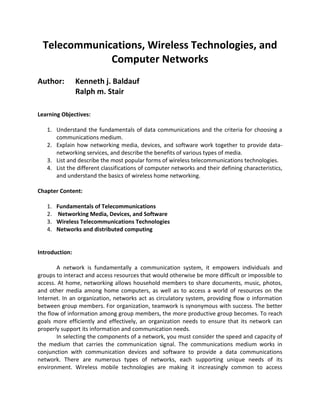
Telecom, Wireless & Network Fundamentals
- 1. Telecommunications, Wireless Technologies, and Computer Networks Author: Kenneth j. Baldauf Ralph m. Stair Learning Objectives: 1. Understand the fundamentals of data communications and the criteria for choosing a communications medium. 2. Explain how networking media, devices, and software work together to provide data- networking services, and describe the benefits of various types of media. 3. List and describe the most popular forms of wireless telecommunications technologies. 4. List the different classifications of computer networks and their defining characteristics, and understand the basics of wireless home networking. Chapter Content: 1. Fundamentals of Telecommunications 2. Networking Media, Devices, and Software 3. Wireless Telecommunications Technologies 4. Networks and distributed computing Introduction: A network is fundamentally a communication system, it empowers individuals and groups to interact and access resources that would otherwise be more difficult or impossible to access. At home, networking allows household members to share documents, music, photos, and other media among home computers, as well as to access a world of resources on the Internet. In an organization, networks act as circulatory system, providing flow o information between group members. For organization, teamwork is synonymous with success. The better the flow of information among group members, the more productive group becomes. To reach goals more efficiently and effectively, an organization needs to ensure that its network can properly support its information and communication needs. In selecting the components of a network, you must consider the speed and capacity of the medium that carries the communication signal. The communications medium works in conjunction with communication devices and software to provide a data communications network. There are numerous types of networks, each supporting unique needs of its environment. Wireless mobile technologies are making it increasingly common to access
- 2. networks anywhere, anytime. This chapter examines a variety of network types and their components to provide an understanding of how networks help us be connected and more productive in business, at home, and while travelling. CHAPTER 1: FUNDAMENTALS OF TELECOMMUNICATIONS Today’s telecommunication networks play a vital role in our daily activities. From the global telecom networks that make up the internet to short-range wireless technologies that pass data back and forth between a cell phone and headset, telecommunications technologies keep us connected. In the first part of this chapter, you will learn the basics about telecommunications systems, how they work, and how their performance is measured. Next you learn about the components that make up telecommunications systems: media, devices, and software. Section three of this chapter delves into wireless networking technologies including cell phones, the Global Positioning System, Wi-Fi, WiMax, Blue-tooth, and radio frequency ID (RFID). The chapter then turns its focus to the different types of computer networks and examines some of the benefits of a wireless home network. Abstraction: Communications can be defined as the transmission of a signal from a sender to a receiver by way of a medium such as wires or radio waves. The signal can contain a message composed of data information. It is important to note two characteristics of communications. First, the message is not communicated directly; rather, it is communicated by way of a signal. Second, the signal itself goes through a communications medium, which is anything that carries a signal between a sender and receiver. You can easily recognize these aspects of communication if you consider what happens when humans communicate. When you talk to someone face to face, you send messages to each other. One person may be the sender at one moment in time and the receiver a few seconds later. This is typical of two-way synchronous communication. In face to face communications, the transmission medium is the air, and the signal is the sound wave.
